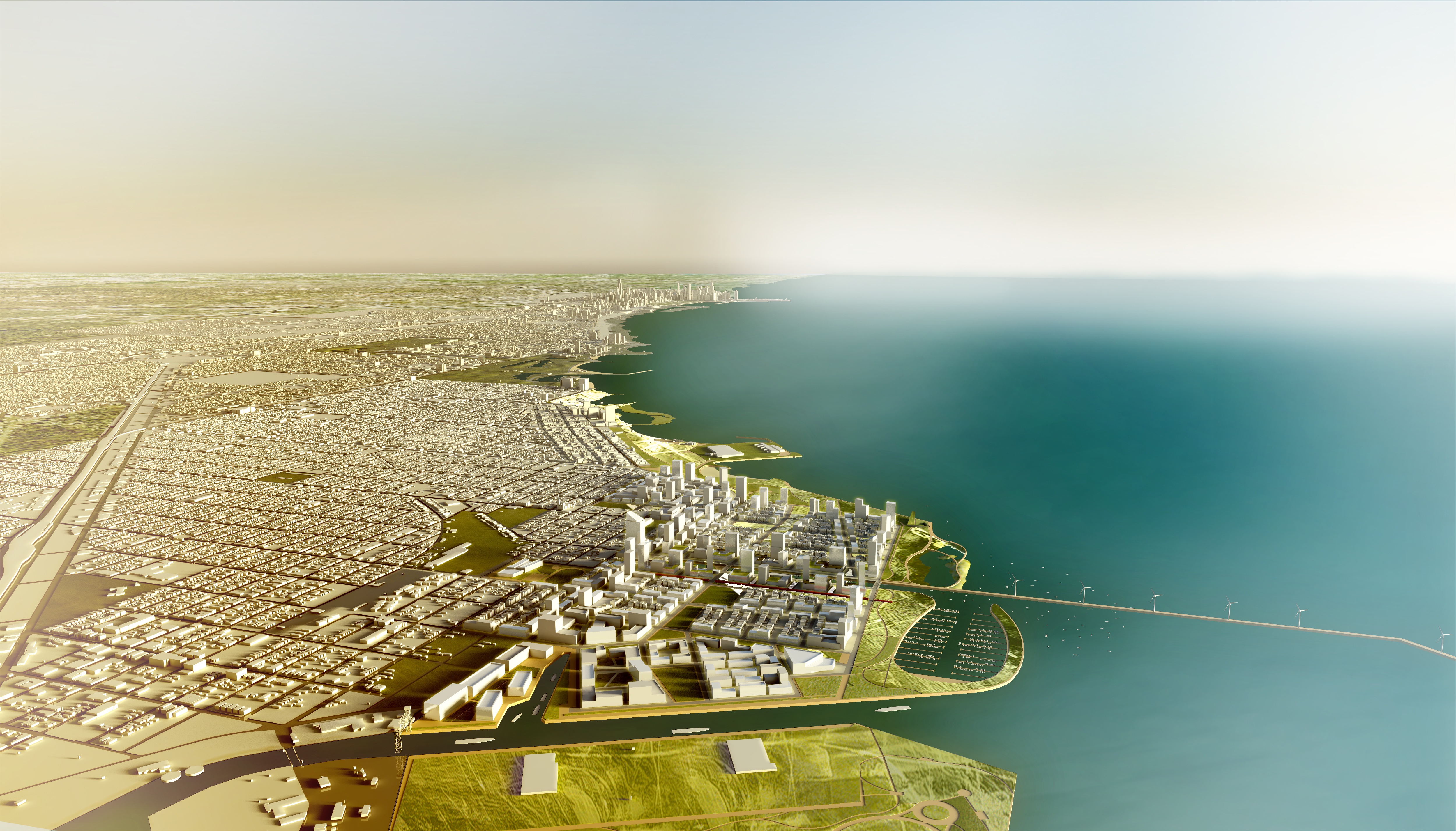The McCaffery Interests and U.S. Steel Corp.’s master plan for Chicago Lakeside, designed by Skidmore Owings & Merrill LLP (SOM), has been named one of 10 finalists for the first Sustainia Award. The project was named to the Sustainia100 in July at the United Nation’s Rio+21 conference as one of 100 projects and ideas from 56 countries that represent the best ideas for sustainability in the world. The inaugural Sustainia Award will “honor the best sustainable solution,” according to organizers.
The winners of the Sustainia Award and the associated Community Award will be announced on Oct. 11 by former California Gov. Arnold Schwarzenegger during a ceremony at the Royal Theater in Copenhagen. Selection of the Sustainia Award winner will be made by a jury consisting of Gov. Schwarzenegger, former Prime Minister of Norway Gro Harlem Brundtland, Intergovernmental Panel on Climate Change (IPCC) Chair Dr. Rajendra K. Pachauri and EU Commissioner of Climate Action Connie Hedegaard. The Community Award winner will be chosen by the general public via voting through Sustainia’s large social media community.
Chicago Lakeside sits on a site of almost 600 acres along Chicago’s Lake Michigan shore. Formerly home to a steel mill, the land is devoid of infrastructure—creating an opportunity to develop the prime lakefront real estate as a 21st century neighborhood.
Plans include a rich mix of proposed uses, including over 15,000 residential units and more than 15-million-square-feet of retail, restaurants, commercial, institutional and research and development facilities. Open space will include two miles of new park land along the shores of Lake Michigan, extending the lakefront park system originally envisioned by Daniel Burnham in his legendary 1909 Plan of Chicago.
The “Lakeside Idea” is about bridging a brownfield industrial past to a green lifestyle future, from steel mill to innovation mill. Lakeside has assembled an international leadership team in the design of future-focused infrastructures – in water and energy conservation, transportation and personal mobility, renewable energy and digital connectivity.
The first work since the demolition of the U.S. Steel South Works more than 20 years ago began earlier this spring when construction began on the extension of Lake Shore Drive through the site between 79th and 87th Streets. The road is scheduled to be complete by December with landscaping work finished in spring 2013, helping to speed commutes for local residents and setting the stage for the initial construction of buildings within Chicago Lakeside soon afterwards. +
Related Stories
| Mar 1, 2014
Dramatic fractal roof highlights SOM's new Mumbai airport terminal [slideshow]
The terminal merges new technology and traditional regional architecture, notably in the fractal roof canopy that runs throughout the terminal.
| Feb 28, 2014
Six finalists selected in design competition for Canadian Holocaust monument
David Adjaye and Daniel Libeskind are among the finalists for the National Holocaust Monument, planned near the Canadian War Museum in Ottawa.
| Feb 27, 2014
Gensler reveals 44 design trends for the next decade
The 82-page report covers dozens of emerging trends in healthcare, commercial office, hospitality, tall buildings, and more.
| Feb 27, 2014
Target converts former prison dump into latest big-box store
Target's new San Rafael, Calif., location was built on the site of the former San Quentin prison dump.
| Feb 27, 2014
Open or private offices? It depends on the business plan
Open layouts are grabbing headlines as a hallmark of the new workplace—think the Google campus or Facebook's headquarters. And for smaller-scale operations, open designs are often lauded for being less expensive than private office plans. But does that mean all offices should have an open layout?
| Feb 27, 2014
3 reasons to apply computational fluid dynamics on your next project
From right-sizing mechanical systems to understanding the impact of design alternatives, CFD offers a host of benefits for the Building Team.
| Feb 27, 2014
12 facts about heat-treated glass: Why stronger isn’t always better
Glass is heat-treated for two reasons: the first is to increase its strength to resist external stresses such as wind and snow loads, or thermal loads caused by the sun’s energy. The second is to temper glass so that it meets safety glazing requirements defined by applicable codes or federal standards.
| Feb 27, 2014
Metal Construction Association introduces two Environmental Product Declarations
Two Environmental Product Declarations (EPD), one for Metal Composite Material Panels and one for Roll Formed Steel Panels for Roofs and Walls, are now available free of charge from the Metal Construction Association (MCA) on its website.
| Feb 27, 2014
Bluebeam Software launches Revu 12 for better field-ready document management and project collaboration
The latest version of the company’s flagship solution better enables users in document-intensive industries to digitally collaborate on project documents and more easily connect the office to the field.
| Feb 27, 2014
PocketCake lunches CPU designed for virtual reality simulations
The company's Virtual Reality Simulation Converter Assembly is three times more powerful than the average high-performance computer and allows for up to eight people to experience a virtual reality simulation at the same time.

















